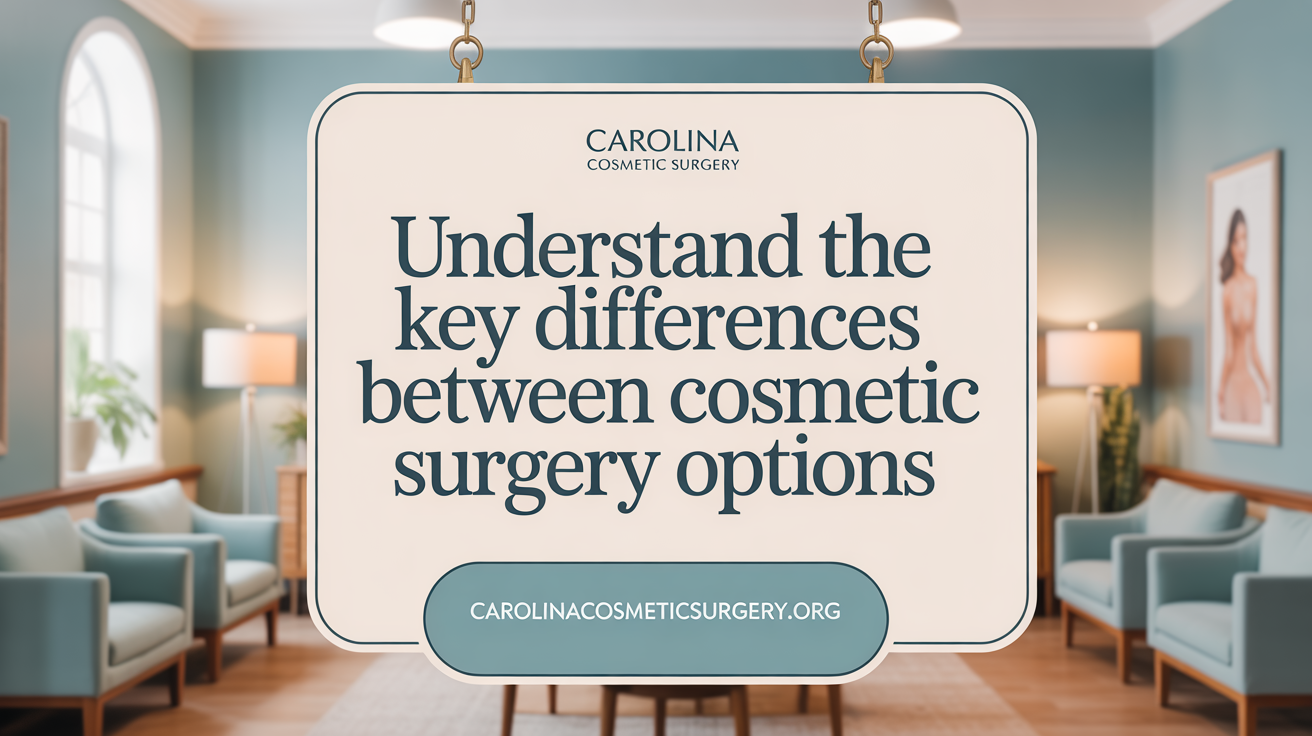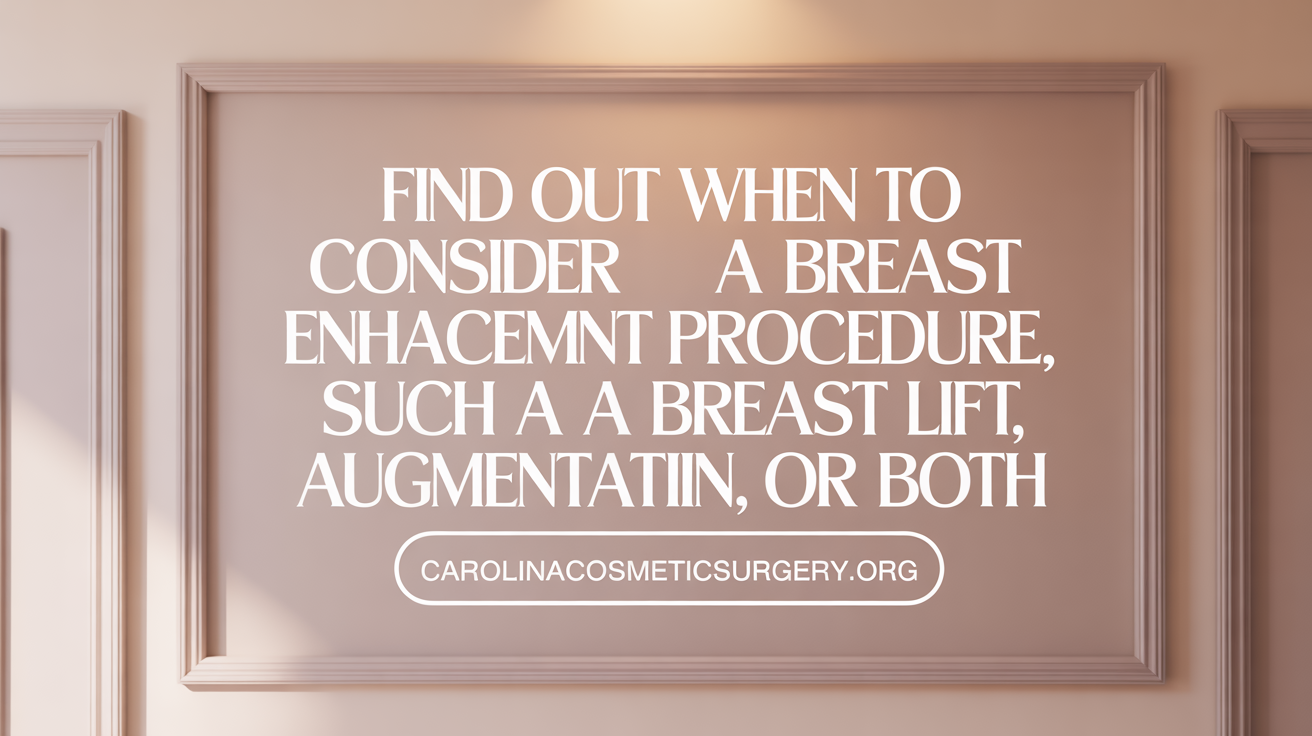Choosing the Right Breast Enhancement Procedure
Women considering breast enhancement face a pivotal choice between two popular surgical options: breast lift and breast augmentation. Each procedure serves distinct purposes, addresses different concerns, and involves unique surgical techniques and recovery experiences. This article helps unpack the key differences, benefits, candidacy criteria, risks, costs, and recovery details so you can make an informed decision tailored to your aesthetic aspirations and personal needs.
Defining Breast Lift and Breast Augmentation: Key Differences and Goals

What are the key differences between a breast lift and breast augmentation?
The key differences between a breast lift and breast augmentation lie in their primary goals and procedures. A breast lift (mastopexy) focuses on correcting sagging (ptosis) by removing excess skin and tightening surrounding tissue to elevate and reshape the breasts, but it does not increase size. In contrast, breast augmentation involves surgically placing implants—either silicone or saline—to increase breast volume and enhance shape, without addressing sagging unless combined with a lift. While a lift improves breast position and firmness, augmentation enhances fullness and size; they can be performed separately or together for comprehensive results. Selection of the appropriate procedure depends on individual goals, breast anatomy, and consultation with a qualified plastic surgeon.
Primary purpose of breast lift
The main goal of a breast lift is to lift and reshape sagging breasts. This procedure addresses drooping caused by aging, pregnancy, or weight fluctuations, and involves removing excess skin, tightening tissue, and repositioning the nipple higher on the chest wall. It results in a firmer, more youthful, and perkier appearance without significantly changing breast size.
Primary purpose of breast augmentation
Breast augmentation aims to increase breast size, volume, and fullness using implants. It is ideal for women with naturally small breasts, those seeking to restore volume after pregnancy or weight loss, or those who want improved breast shape and symmetry. Implants can be silicone gel or saline, and the procedure enhances the overall contour and projection of the breasts.
How each procedure alters breast appearance
A breast lift improves breast shape by elevating the nipple position, removing excess skin, and tightening breast tissue. It results in a more youthful, uplifted look, especially for sagging breasts. Breast augmentation increases the overall size and fullness of the breasts by adding implants, creating a rounder, fuller silhouette. It enhances projection and can correct asymmetry, giving a more balanced appearance.
Surgical techniques unique to each
Breast lift techniques include:
- Periareolar incision: around the areola, suitable for minor sagging.
- Vertical incision: around the areola and down the lower breast, for moderate sagging.
- Inverted-T incision: around the areola, down, and along the crease; used for significant sagging.
Breast augmentation techniques involve placing implants through different incision sites such as inframammary (under the breast fold), trans-axillary (armpit), or periareolar. Implants can be positioned above or below the muscle, with choices tailored to individual anatomy.
| Procedure Type | Main Focus | Incision Types/Placement | Final Impact |
|---|---|---|---|
| Breast Lift | Reshape and elevate breasts | Periareolar, Vertical, Inverted-T | Firmer, perkier breasts, nipple repositioning |
| Breast Augmentation | Increase size and volume | Inframammary, trans-axillary, periareolar | Fuller, more projecting breasts |
Consulting a board-certified plastic surgeon ensures the choice aligns with personal goals, breast tissue condition, and lifestyle, providing natural and satisfying results.
Benefits and Purposes: When to Choose Lift, Augmentation, or Both

What are the benefits and purposes of breast lift versus breast augmentation?
A breast lift, known medically as mastopexy, is primarily aimed at correcting sagging breasts, which often occur due to aging, weight fluctuations, pregnancy, or breastfeeding. This procedure involves removing excess skin, tightening surrounding tissue, and repositioning the nipple and areola higher on the chest wall. The main benefit of a breast lift is the restoration of a more youthful, firm, and perkier breast contour. It improves the shape, position, and overall appearance without significantly changing breast volume.
Breast augmentation, however, is designed to increase the size and fullness of the breasts. This is achieved by inserting implants—either silicone or saline—through small incisions. Augmentation enhances breast projection, shape, and symmetry, helping women who desire larger breasts or want to restore volume lost after pregnancy or weight loss. It focuses on the aesthetic enhancement of size and contour but does not address sagging.
In many cases, women seek both benefits simultaneously. Combining a lift with augmentation can provide a comprehensive transformation, effectively lifting drooping breasts while increasing volume and improving shape for a more youthful and balanced look.
The decision between a lift, augmentation, or both procedures is highly personal. It depends on individual goals—whether the priority is tightening the breasts, adding volume, or achieving both. Consulting with a qualified plastic surgeon helps determine the best approach, ensuring the chosen procedure aligns with the patient’s expectations and anatomical considerations.
In summary, a breast lift is ideal for addressing sagging and repositioning breasts without adding size, whereas augmentation focuses on enlarging and shaping the breasts with implants. When combined, these procedures can correct sagging while augmenting volume, creating a harmonious and youthful breast appearance.
Who Should Consider Each Procedure? Candidate Profiles and Suitability

Ideal candidates for breast lift
Women experiencing sagging or drooping breasts due to aging, pregnancy, breastfeeding, or significant weight fluctuations are typically good candidates for a breast lift. These women often have good skin elasticity and nipples that are positioned below the breast crease or point downward, which can be assessed with the pencil test. They seek to restore a higher, firmer, and more youthful breast contour without a desire for increased volume.
Ideal candidates for breast augmentation
Candidates for breast augmentation usually aim to increase the size and fullness of their breasts. This is often appropriate for women who have experienced volume loss after pregnancy or weight changes, or who simply desire a more proportional or shapely figure. These women generally have adequate skin elasticity and may or may not wish to address sagging. Often, augmentation alone suffices if the nipples are above the breast fold and there is minimal to no significant sagging.
Factors influencing suitability and timing
The decision between a lift and augmentation depends on individual factors such as age, skin elasticity, breast shape, and personal aesthetic goals. Timing is also important; many women opt to have procedures after completing pregnancies and childbearing, as pregnancy can affect results and may necessitate further procedures later.
Use of pencil test in assessing sagging
The pencil test is a simple clinical method for evaluating breast sagging. If a pencil can be securely held under the breast fold or if nipples are pointing downward, it indicates sagging or ptosis. This helps surgeons decide whether a woman is more suited for a lift, augmentation, or a combination of both.
Ultimately, consulting with a qualified plastic surgeon is essential. They can assess individual breast anatomy and help determine the most suitable procedure to achieve desired results, whether it’s lifting, enlarging, or both.
Understanding Risks, Recovery, and Cost Considerations
What are the risks and potential downsides of breast lift surgery?
Breast lift surgery, or mastopexy, is generally safe but carries some risks. Common complications include bleeding, infection, and adverse reactions to anesthesia. There is also a risk of changes in nipple or breast sensation, which can be temporary or permanent. Some patients may experience asymmetry, irregular shaping, or unfavorable scarring. Additional concerns include poor wound healing, fat necrosis, fluid buildup, and the need for revision surgeries. Although rare, serious issues such as blood clots, pulmonary or cardiac problems, or partial or complete nipple loss can occur. Patients should thoroughly discuss these risks with their surgeon and adhere to pre- and post-operative instructions to minimize complications.
How do recovery times and experiences differ between breast lift and breast augmentation?
Recovery varies between the two procedures. A breast lift typically requires about 6 weeks for full recovery, with more discomfort, swelling, and activity restrictions due to skin tightening and tissue reshaping. Patients may experience soreness and must limit physical activities during this time.
In comparison, breast augmentation usually involves a quicker recovery. Many women are able to shower within 24 hours and return to light activities after about a week. Swelling and bruising occur initially but tend to resolve sooner, allowing a faster return to daily routines.
While both procedures require a few weeks for complete healing, the discomfort and length of recovery are generally more pronounced with a breast lift. Patients should plan for a period of limited activity and follow their surgeon’s advice carefully.
What are the typical costs associated with breast lift without implants compared to breast augmentation?
The cost of a breast lift without implants usually ranges from $3,700 to $16,000, with an average around $5,817. Factors influencing price include the extent of skin removal, surgical technique, surgeon experience, and geographic location.
Breast augmentation costs tend to average about $4,294, with a typical range of $3,600 to $9,000. This includes implant type, size, and placement choices.
When combining procedures, such as augmentation with a lift, the expense increases. The total for a combined surgery can be around $15,500 or more, plus additional costs for implants. While a breast lift alone is often less expensive, individual circumstances can affect the final cost.
Consulting with a qualified surgeon will provide a precise estimate tailored to your specific needs and goals.
| Procedure Type | Typical Cost Range | Avg. Cost | Considerations |
|---|---|---|---|
| Breast lift (no implants) | $3,700 - $16,000 | $5,817 | Extent of skin removal, technique |
| Breast augmentation | $3,600 - $9,000 | $4,294 | Implant type, size, placement |
| Combined lift and augmentation | $10,000 - $20,000+ | - | Increased complexity, recovery |
This overview helps patients evaluate their options, balancing expenses with desired outcomes and recovery expectations.
Decision Making: Implant Size, Combination Approaches, and Personalized Consultation
Choosing the right breast implant size is a crucial step in achieving your desired aesthetic results. Implant sizes are measured in cubic centimeters (cc), and although they offer a numerical reference, understanding how they translate to cup size can vary for each individual. Typically, implants in the range of 400–500 cc can yield a D cup, but this depends on factors like your natural breast tissue and chest width. Larger implants, such as 500–600 cc, often result in DD or E cups, and 600–700 cc might correspond to DDD or F. Keep in mind that bra cup sizes are not standardized, so these serve as approximate guideposts.
When considering whether to combine a breast lift with augmentation, it’s important to evaluate your specific needs. A breast lift alone effectively addresses sagging, offering a natural, firmer contour without increasing size. However, if you desire both a lift and increased volume, a combined procedure—augmenting and lifting simultaneously—can deliver comprehensive results. This approach can reduce overall recovery time and ensure better symmetry, especially if your breasts have experienced volume loss along with drooping.
Advantages of combined surgery include a more harmonious final appearance, fewer anesthesia sessions, and potentially lower costs. But it’s a more complex operation requiring a skilled surgeon experienced in both procedures. Consulting a board-certified plastic surgeon is essential to assess your breast condition and set realistic expectations.
Ultimately, the choice depends on your personal goals. Whether you prefer enhanced volume, improved shape, or a combination of both, professional guidance ensures your surgical plan aligns with your body and desired outcomes. Your surgeon will help determine the best approach — implant type, size, and whether a lift is needed to achieve your ideal look.
For more detailed information, searching for topics like "breast implant size selection and combined breast lift augmentation" can provide additional insights into personalized treatment options and surgical planning.
Making the Right Choice for Your Breast Enhancement Journey
Choosing between a breast lift, breast augmentation, or a combination of both ultimately depends on your unique anatomical features, aesthetic goals, and lifestyle considerations. While breast lifts are ideal for correcting sagging and repositioning, augmentations provide volume and size enhancement. A combined approach addresses all concerns for women seeking comprehensive improvement. Careful consultation with a board-certified plastic surgeon is essential to evaluate your candidacy, understand risks, recovery expectations, and costs, and to create a tailored surgical plan. Armed with detailed knowledge, you can confidently embark on your breast enhancement journey toward renewed confidence and comfort.
References
- Breast augmentation vs breast lift - picking the right procedure for you
- Understanding the Difference Between a Breast Lift and Breast ...
- Breast Lift vs. Breast Augmentation: Which Is Right for Me?
- Breast Lift vs. Implants: Which Procedure is Right For Me?
- Breast lift vs breast augmentation vs breast implants – what's the ...
- Breast Augmentation vs. Breast Lift- Which One is Best For You?
- Difference Between Breast Lift & Breast Augmentation | Blog
- Breast Implants Vs. Breast Lift: Which is Right for Me?
